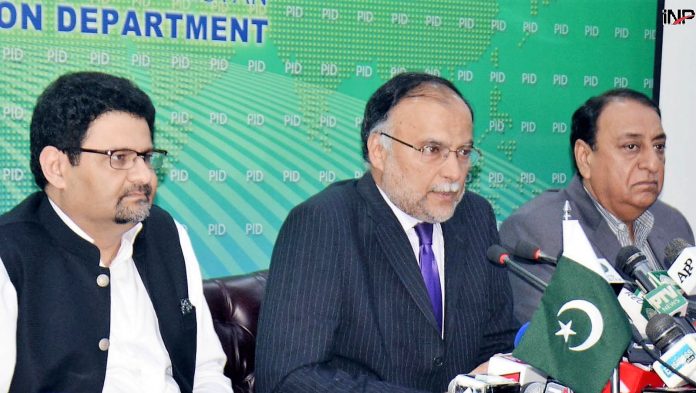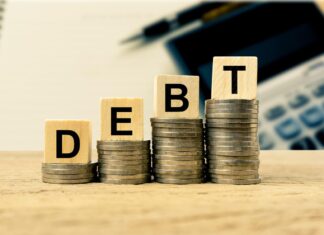ISLAMABAD: Advisor to Prime Minister on Finance, Miftah Ismail has said that the federal government would present the budget for the fiscal year 2018-19 on April 27.
Addressing a joint press conference with Interior Minister Ahsan Iqbal, Finance and Economic Affairs State Minister Ranaz Afzal Khan, Prime Minister’s Adviser on Finance and Revenue Miftah Ismail on Friday said Pakistan Muslim League-Nawaz government would complete its tenure on May 31, adding that the federal budget would be presented on April 27.
About the forthcoming budget, Miftah Ismail said all political parties had been taken in confidence for the upcoming budget. An 11.8 per cent increase in exports was witnessed during the last seven months. He further said that the government has not been able to sell bonds in Pakistani markets for the last seven years, but will be able to from now.
Referring to industries, Ismail said the present government was not responsible for an increase in gas prices. He said the government hopes to achieve GDP growth of six per cent during the current fiscal year, which will be the highest in last 10 years. He added 6 per cent growth rate meant that a sum of Rs200 billion would be injected into the economy.
About the increase in the current accounts deficit, he justified it as a result of heavy import of machinery. He claimed that prices of essential commodities like gas, electricity and others were not increased by the incumbent government.
To a question, he said that State Bank of Pakistan (SBP) has foreign reservoirs of $13 billion. He said SBP reserves would not let down from $12.5billion. He said tax collection has increased 100 per cent.
Speaking on this occasion, Interior Minister Ahsan Iqbal said that heavy investment had been also made in the country’s infrastructure, energy and industrial sectors under the China Pakistan Economic Corridor (CPEC) which would result in giving boost to the national economy.
“CPEC is at initial stage and still its benefits are being felt across the country as far-flung areas of the country are being connected with the big cities through construction of 1650 kilometers motorways besides numerous employment and entrepreneurship opportunities are also surfacing,” he said adding after completion of the mega project in 2030, Pakistan would become hub of regional trade, business and manufacturing.
Ahsan said during last four years, the government had invested over $1 billion to revive the country’s railway system while under CPEC, over $8 billion was being invested to upgrade the railway sector. He informed that Gwadar Master Plan would be completed within five months and after its completion work on a state of the art and one of the smartest Gwadar port would be started.
He said for the first time in country’s history, the government had made it possible to utilise the precious Thar coal and by the end of current year, the local coal would start producing electricity which would continue to produce electricity for next 400 years as the coal reserves in Tharparkar had energy equal to that of Iran and Saudi Arabia’s oil and gas reserves.
According to documents shared by the Ministry of Finance, Pakistan’s public debt dynamics witnessed various positive developments some of them are highlighted below:
The government continued to adhere to the targets set forth in Medium Term Debt Management Strategy (MTDS) to ensure public debt sustainability. Major debt sustainability indicators have improved in last four years of the present government, a fact that is acknowledged by global stakeholders.
“Refinancing Risk of the Domestic Debt Portfolio” was reduced through the lengthening of the maturity profile as a percentage of the domestic debt maturing in one year was reduced to 55.6 per cent at end of June 2017 compared with 64.2 per cent at end of June 2013.
“Exposure to the Interest Rate Risk” was also reduced as the percentage of public debt re-fixing in one year decreased to 47.8 per cent at the end of June 2017 compared to 52.4 per cent at the end of June 2013.
“Share of External Loans Maturing within One Year” was equal to around 27.7 per cent of official liquid reserves at the end of June 2017 as compared with around 68.5 per cent at the end of June 2013 indicating improvement in foreign exchange stability and repayment capacity.
The weighted average interest rate on the domestic debt portfolio has further reduced while the cost of the external debt contracted by the government is not only economical but is also dominated by long-term funding. This reduction led to decrease in interest servicing burden as interest servicing as a percentage of revenue was recorded at around 27 per cent during 2016-17 compared with 33 per cent during 2012-13;
First-ever registered premium prize bond launched, with unique features of both the profits paid biannually and the prize money through quarterly draws.
Around 68 per cent of public debt is denominated in domestic currency. Domestic debt is perpetual in nature and is constantly refinanced through new issues. Domestic market (both primary and secondary) are very well developed and established in Pakistan and as such the government does not feel cause for concern with regard to refinancing its domestic debt.
Regarding the external sector, the ministry claims that a high growth trajectory and rapid implementation of energy and infrastructure projects has increased external sector pressure; current account is likely to be widened around 5 per cent of GDP in FY2017-18. The current account deficit from Jul-Jan FY18 stands at $9.16 billion.
The current account deficit is indicative of higher foreign savings. The robust import demand led by capital goods (20 per cent), petroleum products (23 per cent) and industrial raw materials (9 per cent) highlight significant investment in production activities. RDs are helping contain imports Export-Packagekage has helped in increasing exports by 11.8 per cent from July-January 2017-18 as compared to same period last year.
Exchange rate adjustment has been made and path of flexible exchange rate policy will continue.
In FY 2013, the foreign exchange reserves had hit $ 11 billion, which rose to $ 24.5 billion in October 2016, but have since declined as a result of higher imports of growth enhancing capital equipment and machinery.
























